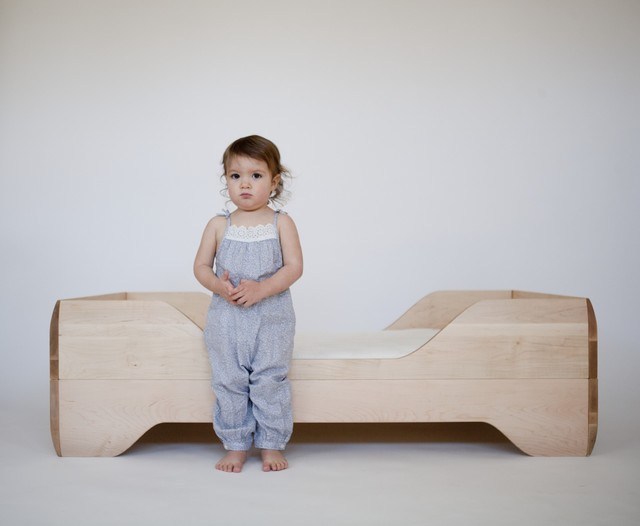Making the transition from cot to toddler bed

I have many parents asking me: when is the right time to make the transition from cot to big kid bed? My recommendation is to wait until your child is at least two years of age, or they begin to climb out of the cot (whichever comes first!).
However, every family circumstance is different, and I appreciate some parents choose to speed up this process for a number of different reasons; including new baby (requiring the cot), to make toilet training easier, or wanting to make the transition from co-sleeping into the child’s own room and bed.
When you do feel that the time is right, here are a few tips to make the transition a little easier:
1) Pick your timing. Avoid moving them into a big kid bed when they are already experiencing other changes in their life (such as toilet training, illness, moving house, new sibling etc.) Similarly, I don’t encourage this transition if your toddler is already experiencing sleep difficulties (e.g. resisting bed time, frequent night wakings etc), as this is a sure way to exacerbate the issue, not improve it.
2) Establish a regular bedtime routine. Make sure you already have a regular bedtime routine in place, and continue to follow this when you make the transition. You may choose to bring bedtime earlier by 30-60 mins on the day you make the transition to allow for an adjustment period, as they may naturally take longer to fall asleep with the new change – 6:30pm – 7:30pm is ideal for children of most ages.
3) Communicate. Let your child know about the move in advance so they what to expect – this will encourage cooperation
4) Encourage safety. Incorporate plenty of fun play in their room every day (and at least three days before making the transition). Ideas include “peek-a-boo”, pillow fights, and rough and tumble – choose any play that fosters safety, connection and makes them laugh – laughter dispels fear which can be heightened during times of change and transition for young children. Refrain from tickling as this can make children feel trapped, vulnerable and unsafe – the very feelings we want to discourage for optimal sleep!
5) Connect. Introduce 10-20 min of quality one-on-one time (distraction free) into your daily routine. Let your child choose the activity (within reason) and let them be the leader – use this time to reach, not teach. This “special time” strengthens the parent-child connection, and builds safety and security, which is effectively the antidote for the fears that most children experience at sleep times in general, and specifically at times of change and transition such as moving from the safe confines of a cot, to an overwhelming and new-found freedom of a bed.
6) Start the transition for the day nap/s, not bedtime at the end of the day. Some children may become more upset or resistant if you start this transition at the end of the day without a “practice run”.
7) Set up the bed in the same position as their cot to increase familiarity.
8) Optimise the sleep environment– particularly ensure its toddler friendly/safe, free from clutter/toys/distractions, dark and warm enough. Some parents choose to install a safety gate temporarily to avoid potential accidents in the middle of the night.
9) Introduce positive and consistent sleep associations eg. Brush teeth, white noise, dark room, read book, kiss/cuddle. Toddler meditation can also help counteract excitedness and/or overstimulation.
10) Listen. Children need to offload their emotions (particularly fear and insecurity at times of change) and do so predominantly through tears and tantrums – day and night!. It’s in our culture to take our child’s behaviour personally, to shame, and punish (e.g spanking, time-outs). But, if we can hold a loving space for our children to release their heavy feelings (by listening lovingly, and offering warm validation and physical closeness) we can assist them to transition with greater ease and velocity. Keep in mind children are extremely efficient at recovering from stress and trauma (either momentary or past-tense). They predominantly cry and/or tantrum to offload heavy feelings with the intent of maintaining emotional equilibrium. If we distract our children, or prevent them from crying during their waking hours – e.g. by use of the dummy, breast, bottle, comforter, rocking or shushing (as an example), they will often wake overnight in order to release these feelings.
OTHER TIPS:
There is always an adjustment period when it comes to changing routine. You can expect that your toddler may begin resisting bedtime, coming out of their bed multiple times before they fall asleep (and overnight), and there may be some tears. If you feel your child needs some extra encouragement on the first few nights, you can either sit with them in a chair beside their bed until they fall asleep, or pull up a mattress on the floor beside them to sleep yourself – just be mindful of creating undesirable sleep crutches!
Keep in mind this is a big transition for parents too! Be patient and kind as you make this change together. If you feel you need more support with moving your toddler into their own room and/or a big kid bed, you can get in touch via my website or Facebook page.
